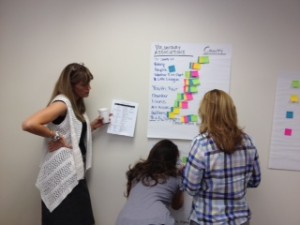Wealth. We usually read about wealth in an individual context. Experts and articles abound, telling us various ways to create and preserve our wealth—our personal assets, particularly financial ones.
Recently, we’ve been hearing more about rural wealth and community wealth-building as well. This discussion recognizes the importance of monetary wealth and other financial assets but considers a wider definition of wealth encompassing the well-being of residents. The literature also recognizes that wealth can be a societal as well as an individual asset.
This 8-part blog series summarizes some of the recent interest in wealth-building in our rural (and not so rural) communities. Specifically, the series covers:
- Defining wealth and wealth-building (Scroll down and keep reading)
- Wealth and inequality
- Wealth in our changing TX Economy
- Strategies for building rural wealth (2 parts)
- Wealth and local government
- Success stories
- Wealth and disaster
Two relatively new resources are Rural Wealth Creation, a 2014 book edited by John Pender, Bruce Weber, Thomas Johnson and Matt Fannin (along with related reports available online), and WealthWorks, a regional (not necessarily rural) wealth building curriculum developed by a set of regional and national partners initially funded by the Ford Foundation. Rural Wealth Creation and WealthWorks carry many similar themes. These resources, along with other publications, data, and my own research, guide the formation of this series. Links to resources relevant to this installment are available at the bottom of the post.
Defining Wealth and Wealth-building
Wealth, as defined for a community context by Pender et al., “includes all types of assets (net of liabilities) that can contribute to the well-being of people” (p. 4).
Both Rural Wealth Creation and WealthWorks use a community capitals framework to explore wealth. The eight capitals are defined in the following image from WealthWorks Module 1:
Image from WealthWorks Module 1, p. 5 http://www.wealthworks.org/The eight capitals of wealth. WealthWorks, Module 1: Explore Regional Wealth Building, p. 5.
Wealth is not merely a monetary phenomenon, although it has a financial component. We might think of the phrase, “S/he’s a wealth of information.” It might be fair to say that person contributes to the intellectual, social, or cultural capital of our community, depending upon the subject of his/her knowledge. Wealth includes our political and natural assets as well as the ones we often reference in an economic sense.
Many times, an asset may be classified as more than one type of capital. When we work with regional planning team, such as our Stronger Economies Together teams, it is interesting to see how an asset appears under multiple capitals. For example, a church might be both a cultural asset and a social asset, and the charitable work of the group provides a financial asset to the community. The church facilities would be a built asset.

CWAM SET team members identify regional assets and barriers using a capitals framework. Photo by author, May 2012.
Some of the financially poorest communities are rich in social and cultural capital. In fact, high social capital is one factor that can actually keep people from moving away to find a new job. The costs of leaving the known support system, combined with actual relocation costs, are perceived to be greater than the benefits of relocation. People outside the community (in fact people outside much of rural America) ask, “Why don’t they just move to where the jobs and money are? It seems they have nothing to lose.” But residents may stand to lose a great deal of capital (assets including child care, emotional support, and pooled resources) by moving. That’s one reason that learning to build upon all of a community’s assets is important.
Wealth-building entails building upon the existing and potential assets of the community. A sense of community (social capital) can be leveraged to create political capital, improve built capital, or beautify natural capital. In fact, Main Street improvement and beautification programs are popular projects in many communities. One example is the Texas Historical Commission’s Main Street Program.
The WealthWorks curriculum stresses keeping local ownership and control of wealth within the region. Many rural assets, from farmland to grocery stores, are owned by non-residents. Communities may be able to identify opportunities to maintain local control or influence.
WealthWorks also emphasizes the importance of improving “the livelihoods of people, places and firms in the region” (Module 1, p. 3). We often distinguish between economic growth and economic development, with growth meaning more overall (more jobs and money) and development indicating better conditions or more per capita. For example, a developing community might look strive to provide jobs with higher pay to people already living in the community—decreasing local unemployment or under-employment and increasing per capita income. At the same time, improving livelihoods means considering the well-being of people who won’t get the jobs—for example, the retired, disabled and others on fixed incomes who might face higher rents and other prices as the community develops. Building the wealth of the community and enhancing all of the community’s capitals can help the entire community to thrive.
Expanding the community to include a broader region provides a larger capital base. In many rural counties, only one town has the school or hospital that the entire county relies upon. Some counties even share services. Thinking regionally expands the economic, social, and environmental assets, creating broader and deeper wealth.
Future blog posts, particularly Strategies for building rural wealth and Success stories, will address various methods of wealth creation.
Resources:
- WealthWorks
http://www.wealthworks.org/ - Rural Wealth Creation
www.rurdev.usda.gov/Reports/rd-ERR131.pdf – USDA-ERS report related to the book
http://www.choicesmagazine.org/choices-magazine/theme-articles/rural-wealth-creation/theme-overview-rural-wealth-creation – Choices Magazine issue on the subject of rural wealth, mostly by book authors - Wealth Creation and Rural Livelihoods
http://www.wealthworks.org/ – includes a forum and listserv - Texas Historical Commission Main Street Program
http://www.thc.state.tx.us/preserve/projects-and-programs/texas-main-street
